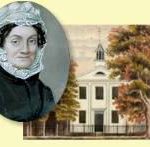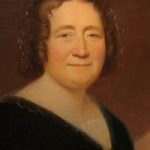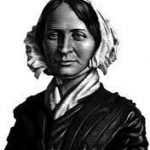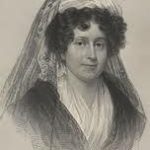Connecticut Educator of African American Girls
Prudence Crandall (1803-1890) was controversial for her education of African American girls in Canterbury, Connecticut. In the fall of 1831, she opened a private school, which was boycotted when she admitted a 17-year-old African-American female student in fall 1833. This is widely regarded as the first integrated classroom in the United States. Crandall is Connecticut’s official State Heroine.
Prudence Crandall was born in Hopkinton, Rhode Island on September 3, 1803 to a Quaker family. In 1820 her father moved the family to the small town of Canterbury, Connecticut. Most women during the early 1800s did not receive much education, but Quakers believed in equal education, regardless of gender. Prudence Crandall attended the New England Friends’ Boarding School in Providence, Rhode Island, where she studied subjects such as arithmetic, Latin and the sciences.
Career in Education
In the fall of 1831, Prudence Crandall returned to Canterbury, Connecticut. In October 1831, with the help of her sister Almira, Prudence purchased the recently vacated Paine mansion on the village green. There she opened a private girl’s academy, where she taught the daughters of many of the town’s wealthy families.
The Canterbury Female Boarding School enjoyed the complete support of the community. Crandall’s curriculum was rigorous, as she taught the same subjects being taught at prominent schools for boys: arithmetic, English grammar, geography, history, chemistry, astronomy and moral philosophy.
The school was soon ranked as one of the best in the state. Basic tuition and room and board was $25 per quarter. Students paid extra fees for instruction in drawing, painting, music and French. With tuition and fees, Crandall was able to pay off the $1500 mortgage within a year.
At that time, white and African American children in Connecticut received a free elementary education at district schools. No further public or private education was available to black children. Crandall became aware of these injustices through her housekeeper Marcia Davis, and Marcia’s friend Sarah Harris, both African Americans.
Sarah’s father was a free African American who owned a small farm near Canterbury, and he was the local distributor of the abolitionist newspaper, The Liberator, and Marcia sometimes left copies of the newspaper where Crandall would see them. Sarah had attended the same district school as the white girls who were now attending Crandall’s school as teenagers.
In the fall of 1832, Sarah Harris asked Crandall if she might be allowed to attend the Canterbury Female Boarding School. Originally from Norwich, Connecticut, a town with a large African American population, Sarah Harris’ dream was to return to Norwich and teach African American children there. Crandall’s academy could give her the education she needed to achieve that goal.
As a Quaker, Prudence Crandall opposed slavery and believed in educating African Americans, but was uncertain of what the repercussions might be if she admitted a black student. After much soul searching, during which she had to face her own surprising prejudices, Crandall agreed to allow Harris to attend the school as a day student.
A number of Canterbury’s leading gentlemen, including the secretary of Board of Visitors for Crandall’s school, were supporters of the colonizationist movement who feared the integration of the races and proposed sending all African Americans in the United States to Africa. This issue was being passionately debated at the time Crandall admitted Sarah Harris to her school.
When word got out that there was a black girl attending classes at the Canterbury School, many prominent townspeople objected and pressured to have Harris dismissed from the school, but Crandall refused. Parents then threatened to withdraw their daughters if Harris remained in the school.
Prudence Crandall soon realized she must find another way to keep the school open. In early 1833, she traveled to Boston to meet with prominent abolitionist William Lloyd Garrison, publisher of The Liberator. They discussed the possibility of closing the academy and reopening with only African American students. With Garrison’s assistance Crandall traveled throughout the northeast, seeking students and supporters. In late February 1833, she dismissed her remaining white students.
The Opposition
Prudence Crandall’s excitement and sense of accomplishment at running a school to help young black women was short-lived. She was immediately ostracized by her neighbors, and criticized by her community and the state of Connecticut. A delegation of town leaders urged her to abandon the project, but Crandall refused.
A doctor who lived opposite the school, Andrew Harris, refused to treat her black students even though he had been one of her original trustees. One week after the The Liberator ad appeared, politician Andrew Judson, who was also a close neighbor and former Crandall trustee, seized a hastily called town meeting as a platform. No school for “n—-r girls” would ever stand across the street from his house, he was said to have vowed, promising that if black students did show up he would use an old Colonial law to have them arrested as paupers.
The four most prominent men in Canterbury arranged a meeting in which they told Crandall that they were intent on destroying her school. The men objected to educating African Americans in their town. Women in the 1800s were raised to obey men’s wishes, but Crandall was strong in her convictions and did not to bend to public pressure.
On March 9, the town held a protest meeting in response to Crandall’s proposed school. In 1833, women could not vote, hold public office or speak at public meetings. Therefore, Crandall enlisted Unitarian minister Samuel May and abolitionist lecturer Arnold Buffum to represent her at the meeting. The three decided that they would offer to relocate the school further away from the center of town if someone would buy Crandall’s current home.
Although they tried, May and Buffum were not allowed to speak at the meeting on the grounds that they did not live in the town of Canterbury. The town voted to protest the school. May (uncle of future author Louisa May Alcott) waited until the meeting was over to make his speech. Some people stopped to listen, but one of the prominent townspeople ordered everyone out of the building.
Although the School for Young Ladies and Little Misses of Color opened with only three students on April 1, 1833, Crandall had recruited others from Boston, Providence and New York City. Enrollment soon rose to 24 students, most of whom were boarders. The curriculum was identical to that of Crandall’s first Canterbury school.
Inside the school, the girls enjoyed the peaceful activities of lectures and study but when they ventured outside they were met with threats and violence. The townspeople jeered rude comments at the girls and threw stones, eggs and manure at them. Shopkeepers refused to sell them food. The town doctors would not attend to their needs.
Most store owners refused to sell Crandall the goods she needed to run the school; she was forced to have her supplies shipped in. The Congregational church refused to allow her students to attend services, while other townspeople contaminated the water in the school’s well with animal feces. Under the cover of darkness, someone attempted to set fire to the building in January 1834.
At this time, in Connecticut, as elsewhere, the notion of black equality was at odds with the nearly universal belief of whites in their own superiority. Many abolitionists did not think slaves should become citizens. These were colonizationists who believed that blacks could never live peacefully in white America and should be sent back to Africa. They feared crime and discord, and worse, ‘amalgamation,’ the prospect of whites and blacks mixing socially and carnally.
Despite all this, in mid-April Crandall wrote, “In the midst of this affliction, I am as happy as any moment in my life.”
Connecticut’s Black Law
Lacking no legal means to prevent Prudence Crandall from opening her school, on May 24, 1833, local politician Andrew Judson pushed legislation through the Connecticut Assembly. The so-called ‘Black Law’ made it illegal for African American students from outside the state to attend a school in Connecticut without local permission. In Canterbury, people rang church bells, fired guns and lighted bonfires to celebrate the new law.
“We are under no obligations, moral or political to incur the incalculable evils of bringing into our own state colored immigrants from abroad,” the report said. It noted that Connecticut, which had long since ordered the gradual emancipation of resident slaves and allowed blacks to attend lower district schools, had the right to determine who should enjoy full citizenship.
Convinced the Assembly’s action was neither morally just nor constitutionally correct, Crandall ignored the law and continued to recruit and teach her students until her arrest on June 27, 1833. She was placed in the county jail for one night and then released under bond to await her trial. Crandall was charged with instructing students who were not inhabitants of Connecticut without the prior consent of the civil authority and selectmen of her village in violation of the Black Law.
One of Crandall’s students, 17-year-old Anna Eliza Hammond, was also arrested; however, with the help of Samuel May, she was able to post bail bond through collections and donations of $10,000. In response to May’s support of Crandall, Andrew Judson stated:
Mr. May, we are not merely opposed to the establishment of that school in Canterbury; we mean there shall not be such a school set up anywhere in our State. The colored people can never rise from their menial condition in our country; they ought not to be permitted to rise here. They are an inferior race of beings, and never call or ought to be recognized as the equals of the whites.
The Black Law and Crandall’s resistence to it sparked a year-long debate among New Englanders on the issues of abolition and colonization. The Liberator thundered against the injustice, and soon all of America knew of Canterbury and Prudence Crandall. The conflict allowed abolitionists to dramatize the evils of prejudice. Leaders in the movement helped Crandall recruit students for her school, gave her support, and provided for her financially.
The Trials
Prudence Crandall’s first trial was held on August 23, 1833 at the Windham County Court. Prominent abolitionist, Arthur Tappan of New York, donated $10,000 to hire the best lawyers to defend Crandall. Newspapers carried long stories describing the testimony. However, the testimony of witnesses was less important than the lawyers’ arguments and the judges’ rulings.
Crandall’s defense was led by William Ellsworth, the son of Oliver Ellsworth, a signer of the Declaration of Independence in 1776. Ellsworth contended that because blacks had received Revolutionary Army war pensions and were considered citizens in other states, they should also be considered citizens of Connecticut.
Prosecutor Andrew Judson responded with a Catch 22 type argument: If blacks could not vote, as in Connecticut they could not (the new state constitution of 1818 specifically denied them the franchise), then it followed that they could not be considered full citizens. He also stated that freed African Americans were not designated as citizens in any state.
The county court jury ultimately failed to reach a verdict, and the case went to a second trial in October 1833, at which Crandall’s lawyers challenged the Black Law on the grounds that it violated the clause in the U.S. Constitution that said no state could deny to others rights it gave its own citizens. The crucial question was whether blacks could be considered citizens.
Judge David Daggett told the jury that this case raised “the great question” of whether blacks were citizens under the U.S. Constitution:
To my mind, it would be a perversion of terms, and the well-known rule of construction to say that slaves, free blacks or Indians, were citizens within the meaning of that term, as used in the Constitution. God forbid that I should add to the degradation of this race of men; but I am bound by my duty, to say they are not citizens.”
According to this argument, the Constitution did not entitle African Americans to the freedom of education. This time Crandall was found guilty but appealed the decision to Connecticut’s Supreme Court. While she and her abolitionist supporters pursued their legal challenges to the Black Law, her school continued to operate.
The Crandall case was taken to the Supreme Court of Errors on appeal in July 1834. The Supreme Court of Connecticut reversed the decision of the lower court, dismissing the case on July 22, 1834 because of a technicality. The lower court decision that African Americans were not protected as citizens, however, remained standing.
The Violence
In the meantime, Prudence Crandall, her students and their supporters had been targets of varying degrees of harassment. The threats and violence tended to increase when it appeared the legal tactics were failing. Although Crandall had won a technical legal victory and was free to return to her school, the townspeople of Canterbury seemed to be unable to accept the Supreme Court’s decision.
In August 1834, despite all the turmoil in her life, Prudence Crandall married Calvin Philleo, a Baptist minister and fellow abolitionist who had three children from an earlier marriage.
On the night of September 9, 1834, Crandall, her new husband and some of her black female students were inside the school when they heard loud voices outside and then banging on the doors. They heard glass breaking and windows being ripped from their frames. Then, men invaded the first floor and began to overturn furniture. They may have also tried to set fire to the school.
In any case the attackers got what they wanted. The damage was great enough that a friend of Crandall’s who arrived the next day said it was foolish to repair the school only to have it destroyed again. Crandall also knew of recent anti-black riots in New York and Philadelphia and may have worried that she could not protect her students.
Her husband Calvin Philleo might have been a factor in her decision to close the school. They had been married less than a month when the school was attacked, but it was long enough for Crandall to realize that the marriage had been a mistake. Before the attack, Philleo had a grand plan to expand the school. After the attack, he placed the ad offering the school for sale.
For the safety of her students, her family and herself, Prudence Crandall closed her school on September 10, 1834. Within days the mansion that served as the school building was up for sale, the students gone, and Crandall in retreat to her father’s farm outside Canterbury.
In 1835 Crandall moved with her husband to his small farm in upstate New York, where she cared for his two ailing children and tried to cope with his erratic behavior. He ran up debts, began to have lapses of memory while preaching and forbade Crandall to read books. When he fell in a fit into a blazing fireplace one day, she saved him from burning to death.
Soon after the close of Crandall’s school, the tide of abolitionism had begun to turn in Connecticut. A new anti-slavery society was established. Phillip Pearl, the chairman of the committee that had passed the Black Law, told a friend, “I could weep tears of blood for the part I took in that matter – I now regard that law as utterly abominable.” In 1838, Connecticut’s Black Law was repealed.
To the West
Prudence Crandall’s father, who had been threatened for supporting her and her school, had moved west to the Illinois frontier, seeking a place more peaceful than Connecticut. During the next few years Prudence suffered a string of tragic losses. Her younger sister Almira, who had taught with her at the Canterbury School, died in 1837. In 1838 her brother Reuben, three years younger than Prudence, died in 1838; her father died later the same year.
In 1842, Crandall left the East to work the farm her father had bought in Troy Grove, Illinois just before his death. There, she continued to teach and ran a school from her home. She also participated in women’s rights activities, making speeches for the suffrage movement and for tolerance.
Crandall never had children, but she rarely was alone. One member or another of her extended family – her surviving brother, Hezekiah, and his children; Philleo’s son and grandchildren – lived with her at one time or another. Even her mother came West to be cared for in her old age.
Crandall went back East only once, to teach briefly in Boston. But she soon returned to the Troy Grove farm. By the end of the Civil War she had established other homes in the Illinois towns of Mendota and Cordova even as the Troy Grove property stayed in the family.
In 1865, Crandall moved to the Rock Island area, but she was in constant financial distress. Through the years Calvin Philleo continues to suffer from mental illness. As he aged, he became a quieter and more constant presence in her various households. Philleo died in 1874 at age 87.
Two years later, at age 73, Prudence Crandall moved one last time, with her brother and his family, to a 160-acre farm even further west in the new settlement of Elk Falls, Kansas, where she started a school that served American Indians.
Throughout her life, Prudence Crandall remained engaged in life. She became involved in the causes of temperance and women’s suffrage. She wore pants. She invited black emigrees from slave states to visit. She also embraced spiritualism, as did other prominent Americans such as Harriet Beecher Stowe, and was declared a heretic by the Baptist Church.
In 1883, Mark Twain helped obtain a $400 a year pension for Prudence Crandall from the Connecticut Assembly. One hundred and twelve citizens of Canterbury had signed a petition requesting the pension and said they were ashamed of how they had treated Prudence. Twain also offered to buy her former home in Canterbury for her retirement, but Crandall kindly declined the offer.
In her last years, journalists sought out the old woman who already seemed to them a historical figure. Her brother had died and they found her living in a rudely furnished, book filled 8 foot by 12 foot cabin. Nevertheless she professed to be happy there and still idealistic.
She was quoted in an 1885 Topeka paper:
I like Kansas very much. My humble dwelling is situated in one of the most beautiful spots on earth. The aspirations of my soul to benefit the colored race were never greater than at the present time. I hope to live long enough to see a college built on this farm, into which can be admitted all the classes of the human family, without regard to sex or color… I want professorships of the highest order… You see that my wants are so many, and so great, that I have no time to waste, no time to spend in grief…
Prudence Crandall died at Elk Falls on January 27, 1890 at age 87.
My Favorite Prudence Crandall Quote (1833):
I said in my heart, here are my convictions. What shall I do? Shall I be inactive and permit prejudice, the mother of abominations, to remain undisturbed? Or shall I venture to enlist in the ranks of those who with the Sword of Truth dare hold combat with prevailing iniquity? I contemplated for a while the manner in which I might best serve the people of color. As wealth was not mine, I saw no other means of benefiting them than by imparting to those of my own sex that were anxious to learn all the instruction I might be able to give, however small the amount.
SOURCES:
The Real Canterbury Tale
NWHM: Prudence Crandall
Wikipedia: Prudence Crandall
Connecticut’s “Black Law” (1833)
NPS.gov: Prudence Crandall and the Canterbury Female Boarding School






